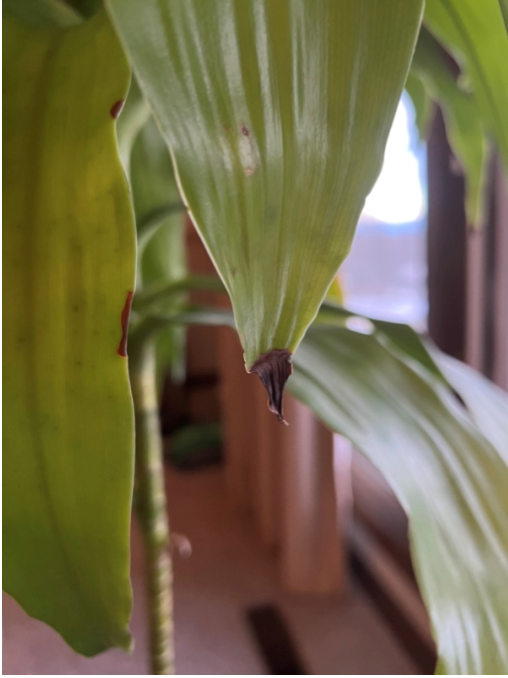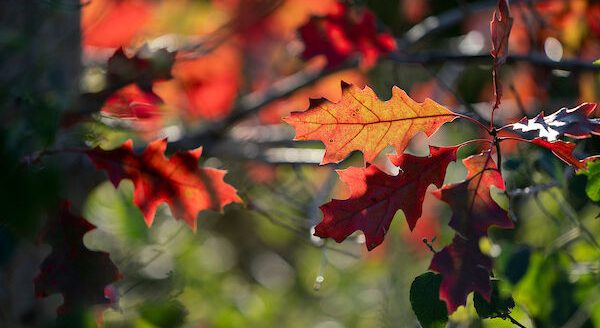Know what to look for on houseplant leaves and stems
Growing houseplants is a rewarding hobby that yields beautiful results. But when houseplant problems arise, it can be difficult to determine what to do to fix the issue. In this week’s Yard and Garden column, Iowa State University Extension and Outreach horticulture specialists answer questions on how to address common issues seen on houseplants.
Why does my houseplant have brown leaf tips and edges?
Brown leaf tips or edges can happen on any indoor plant but are common on some species like spider plant and dracaena. The most likely cause is low humidity. The humidity levels in homes are often low, especially during the winter months. Raise humidity levels by using a humidifier, pebble tray, terrarium, or by grouping plants together to allow their collective foliage to hold in more humidity.
Inconsistent watering, in particular allowing plants to dry out too long between waterings, will cause leaf edges and tips to turn brown. Excess salts can build up in the soil when too much fertilizer is applied, which can also lead to brown leaf tips. Water and fertilize appropriately to prevent further browning.
Too much chlorine and other chemicals in the water, such as fluoride, can cause brown leaf tips, especially over an extended period of time on sensitive species like spider plant, dracaena, prayer plant and calathea. Use a different water source if this issue is suspected.
Trimming the brown portions off the leaves with a pair of scissors can improve appearance, but new browning will occur if the root cause is not addressed.
What causes leaves on my houseplant to turn yellow or brown and drop off?
Yellowing, browning and dropping of leaves is one of the most vague and difficult symptoms to deal with because it can be caused by a wide variety of issues. Many of the problems seen in houseplants are not caused by just one factor; they are the result of several factors coming together. It is important to investigate all potential causes and take corrective action to ensure the issue is fully resolved.
Improper environmental conditions are the leading issue that causes leaf drop. Be sure temperatures are not extreme. If plants were not protected from cold in transport or experience blasts of cold or warm air from doors, windows or air ducts, leaves are likely to yellow and drop. Check watering practices, as over- and under-watering can lead to these symptoms. Plants that are under-fertilized will often develop yellow leaves. Low humidity will cause the browning and eventual drop of leaves. Light levels that are too high or too low, as well as a sudden change in light intensity, will cause leaf drop. Always change light intensity levels gradually when moving plants to new locations.
Why is my houseplant wilting?
Wilting is the result of roots not being able to provide adequate moisture to the leaves and stems. It can be caused by two completely opposite reasons, either under-watering or over-watering, which can make it difficult to diagnose and solve. First, check for dry soil conditions. If the root ball is dry too long or dries out very quickly, roots do not have access to water and plants wilt. Water more frequently and thoroughly, making sure the entire root ball is wetted. If the container is too small and plants are rootbound, repot in a larger container.
If soil conditions are too wet, especially over an extended period of time, roots begin to rot and die. With fewer roots, the stems and leaves do not have access to enough water, and they wilt. Always let the soil dry thoroughly between waterings. Check for water on a regular basis and only water when the soil is dry to the touch an inch or two down. Make sure the container has a drainage hole and that saucers and outer pots and sleeves are not allowed to hold water. If the soil is old and broken down becoming more compacted, it will hold more water, leading to potential rot. If this is the case, repot in fresh, well-drained soil.
What is this sticky substance all over the table, floor, and lower leaves of my houseplant?
Honeydew is a sticky, sugar-rich substance produced by insects that suck sap from plant leaves and stems. This excretion often coats lower leaves, tables and floors and when severe, may promote the growth of black sooty mold.
Several common insect pests produce honeydew on indoor plants including scale, mealybug and aphids. Inspect leaves and stems for scale insects, which look like small bumps or scales clustered along stems and on the undersides of leaves. If cottony, white masses are found clustered along leaf axils or on the undersides of leaves, then plants are infested with mealybug. Aphids are small, soft-bodied insects, often green, brown, or reddish in color and found clustered on growing points, underneath leaves, along stems and on flower buds.
Control of these insects can be difficult. Start with a good rinse or wipe-down using a damp cloth to remove honeydew and sooty mold, and dislodge insects like aphids and mealybug. Scale and mealybug can be physically removed with a thumbnail or dabbed away with a cotton swab dipped in rubbing alcohol when infestations are small. Prune out heavily infested leaves and stems. Consider the use of an insecticide such as insecticidal soap, neem oil, horticultural oil or pyrethrin. Check the label to be sure both the plant species and the pest insect are listed and always follow label directions. Multiple, thorough applications of insecticide on a weekly basis for four to six weeks will be needed for complete control. If plants are heavily infested, it may be better to discard the plant before other houseplants are affected.


